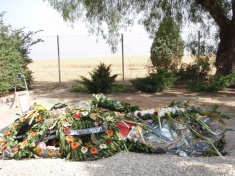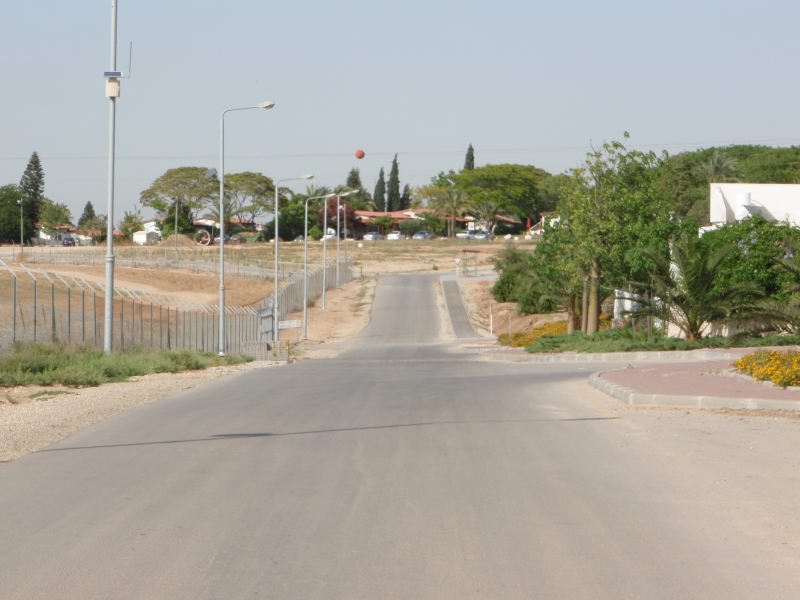
On this day, what seemed like the entire kibbutz gathered around the Kedoshim family. They were not there to film the funeral for TV or write an article for a newspaper, but to hear stories about Jimmy, to honor and mourn the memory of their tragically fallen friend and neighbor.
Sadly, the people of Kfar Aza were not afforded that right today. From the kibbutz’s cemetery, as well as many of the residences, just over the horizon of seemingly peaceful golden fields, the buildings of Gaza’s cities are in plain site. And as we face the Kedoshim family, our backs are to Gaza and Hamas, who presumably lie in wait after hitting Sapir College campus in Sderot with two kassam rockets just hours earlier.
As hard as every person at the funeral tried to give their undivided attention to Jimmy’s family and his memory, with every gust of wind and every rattle in the distance, several people at any given mooment, including myself, could not help but turn our backs on the Kedoshim to take a peak over the horizon. For listening for the wail of the siren is no longer good enough. The first warning sign of a mortar attack is when one hits the ground, a building, a car-or as it was in Jimmy’s case, a person.
Kfar Aza
Kibbutz life is supposed to be the quiet life, a community oriented life where not only does everybody know each other, but they also depend on each other.
“I really think this is the best way to grow up,” said Hadas Golan, 23, who will be traveling to Los Angeles, Calif. in the coming weeks to speak at a United Synagogue Youth event about life in the Western Negev. “The kids grow up very close to each other, they can walk around the kibbutz alone, and when they get to high school age they can move into the dormitories.”
And on this day and at this moment, Kfar Aza is that place. Children are out on the playground, the grass is green, and the trees are in bloom. But this peaceful atmosphere is rather unusual for Kfar Aza. The days are usually peppered with rocket and mortar fire from Gaza, which is just a few kilometers away from the Kibbutz.
There is a particularly good view from the fence on the edge of the kibbutz that separates the homes from the green and golden farmland that stretches almost right up to the border, where farmers are occasionally targets for gunmen from Gaza. A volunteer from Venezuela died from one such attack last year.
The eastern end of the cemetery also provides a view of Gaza, especially from the grave of Jimmy Kedoshim, the 48-year-old Kfar Aza man who died in a mortar attack on Friday. It was a view that became all too familiar throughout the services, as every gust of wind through the trees conjured up worries that another Hamas mortar attack could be on the way, baiting mourners to turn their gaze away from Jimmy’s grave toward Gaza, just visible over the horizon of the golden fields behind.
After attending Jimmy Kedoshim’s funeral on Monday, I returned to Kfar Aza to take a sort of tour of the Kibbutz. Hadas Golan, introduced me to the center of the kibbutz, where the young children go to school and play on the playground and residents eat lunch at the cafeteria and shop at the market.
Naturally, there is also a bomb shelter nearby for people to run to when they hear the Tzeva Adom alert. The alert is part of an Israeli system along the border that warns Western Negev residents when terrorists fire rockets from Gaza. It picks up the heat signature from the rocket and sets off the alert, which gives residents approximately 15 seconds to find shelter.
“We go to the shelters for safety whenever the Tzeva Adom alert goes off, but this shelter is only 20 cm thick,” Hadas said. “If it takes a direct then everybody inside of it could die. I’m not sure if we have any 40 cm shelters.”
The kassam rockets are something to which the kibbutz has become accustomed. While they still jump a bit when they even hear somebody on a megaphone, they “know the drill.” When the alert goes off, the kibbutzniks run for a shelter. However, now Hamas is using a new weapon against the Western Negev’s civilians: advanced mortars.
While in the past, Hamas has used low caliber homemade mortars, it has started using Iranian made 120 mm mortars, that have a range of up to 10 km, to shell the closer Western Negev cities and kibbutzim. Unlike the case of Qassams, there is no warning system for mortars, as they do not produce the heat to set off the Tzeva Adom alert and have a shorter range and flight-time.
“This is something new for us,” Hadas said. “For the Qassam’s, we have the alert, but the mortars are different, and there is no alert. We don’t know to go to the shelters until one actually hits.”
And at that point it might already be too late, as was the case for Jimmy Kedoshim. He was killed by the first mortar during the attack on Friday.
As she took me around the rest of the kibbutz, we passed the swimming pool.
“Kibbutz Mefalsim did not open the pool this year, so we were supposed to have their kids come here to use our pool,” Hadas said. “It hasn’t happened yet because of the danger, but they will come eventually.”
The constant rocket fire and increased mortar attacks have done more than just changed the way residents live. It has actually changed the way they think, Hadas said.
“In a normal place, when you see damage to a building or a hole in the road, there are a million explanations you can think of, but here, for us, there is only one explanation.
“And after all this time, it’s no longer ‘if’, but ‘when’. And when it happens, we think that it is just your destiny.”
On the way out of the Kibbutz, there was group of adults coming out of the school, which Hadas said were social workers who were there to help the children cope with Jimmy’s death and the constant attacks. Jimmy was well known as a leader on the kibbutz, and to the children because in years past, he would put on a parachuting show for them on Yom Ha’atzmaut.
Even when there is no rocket or mortar fire, life is anything but peaceful in Kfar Aza these days.










